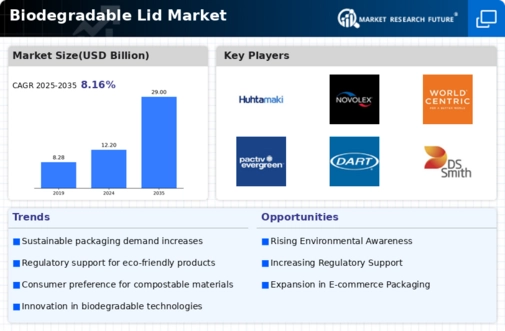Rising Environmental Awareness
The Global Biodegradable Lid Market Industry experiences a surge in demand driven by increasing environmental awareness among consumers and businesses. As individuals become more conscious of the ecological impact of plastic waste, there is a notable shift towards sustainable alternatives. This trend is reflected in the projected market value of 12.2 USD Billion in 2024, as consumers actively seek products that align with their values. Companies are responding by innovating biodegradable lid solutions, which not only reduce landfill waste but also enhance brand reputation. This growing consciousness is likely to propel the industry forward, fostering a culture of sustainability.
Regulatory Support and Policies
Government regulations and policies play a pivotal role in shaping the Global Biodegradable Lid Market Industry. Many countries are implementing stringent regulations aimed at reducing plastic usage and promoting biodegradable materials. For instance, bans on single-use plastics are becoming increasingly common, compelling manufacturers to pivot towards biodegradable options. This regulatory landscape is expected to contribute to the market's growth, with projections indicating a market value of 29.0 USD Billion by 2035. Such policies not only encourage innovation but also create a favorable environment for biodegradable lid manufacturers, enhancing their market presence.
Consumer Demand for Sustainable Packaging
The Global Biodegradable Lid Market Industry is witnessing a robust increase in consumer demand for sustainable packaging solutions. As consumers prioritize eco-friendly products, businesses are compelled to adapt their packaging strategies accordingly. This shift is evident in various sectors, including food and beverage, where biodegradable lids are increasingly favored over traditional plastic options. The market's projected growth to 12.2 USD Billion in 2024 underscores this trend, as companies recognize the importance of aligning their offerings with consumer preferences. This demand for sustainable packaging is likely to drive innovation and competition within the industry.
Technological Advancements in Material Science
Advancements in material science are significantly influencing the Global Biodegradable Lid Market Industry. Innovations in biopolymers and other biodegradable materials are enabling the production of lids that are not only environmentally friendly but also functional and cost-effective. These technological improvements are likely to enhance product performance, making biodegradable lids more appealing to manufacturers and consumers alike. As a result, the market is anticipated to grow at a CAGR of 8.16% from 2025 to 2035. This growth trajectory suggests that ongoing research and development efforts will continue to yield new materials that meet the demands of a sustainable future.
Growth of E-commerce and Food Delivery Services
The rise of e-commerce and food delivery services is significantly impacting the Global Biodegradable Lid Market Industry. As online shopping and food delivery become more prevalent, the need for sustainable packaging solutions has intensified. Companies in these sectors are increasingly adopting biodegradable lids to meet consumer expectations for environmentally responsible packaging. This trend is expected to contribute to the market's growth, with projections indicating a market value of 29.0 USD Billion by 2035. The alignment of consumer behavior with sustainability goals presents a unique opportunity for biodegradable lid manufacturers to expand their market reach.






















